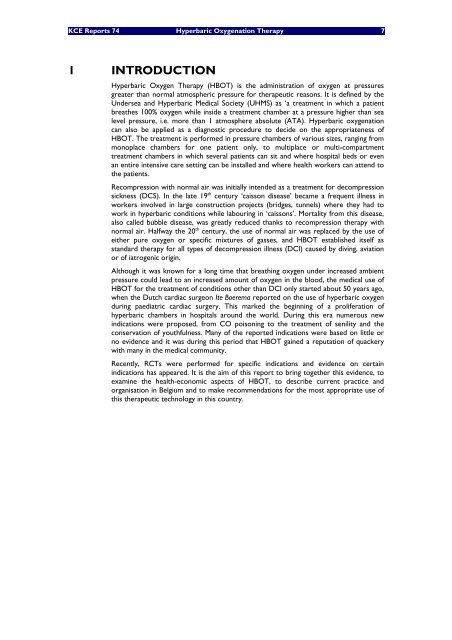Hyperbare Zuurstoftherapie: Rapid Assessment - KCE
Hyperbare Zuurstoftherapie: Rapid Assessment - KCE
Hyperbare Zuurstoftherapie: Rapid Assessment - KCE
You also want an ePaper? Increase the reach of your titles
YUMPU automatically turns print PDFs into web optimized ePapers that Google loves.
<strong>KCE</strong> Reports 74 Hyperbaric Oxygenation Therapy 7<br />
1 INTRODUCTION<br />
Hyperbaric Oxygen Therapy (HBOT) is the administration of oxygen at pressures<br />
greater than normal atmospheric pressure for therapeutic reasons. It is defined by the<br />
Undersea and Hyperbaric Medical Society (UHMS) as ‘a treatment in which a patient<br />
breathes 100% oxygen while inside a treatment chamber at a pressure higher than sea<br />
level pressure, i.e. more than 1 atmosphere absolute (ATA). Hyperbaric oxygenation<br />
can also be applied as a diagnostic procedure to decide on the appropriateness of<br />
HBOT. The treatment is performed in pressure chambers of various sizes, ranging from<br />
monoplace chambers for one patient only, to multiplace or multi-compartment<br />
treatment chambers in which several patients can sit and where hospital beds or even<br />
an entire intensive care setting can be installed and where health workers can attend to<br />
the patients.<br />
Recompression with normal air was initially intended as a treatment for decompression<br />
sickness (DCS). In the late 19 th century ‘caisson disease’ became a frequent illness in<br />
workers involved in large construction projects (bridges, tunnels) where they had to<br />
work in hyperbaric conditions while labouring in ‘caissons’. Mortality from this disease,<br />
also called bubble disease, was greatly reduced thanks to recompression therapy with<br />
normal air. Halfway the 20 th century, the use of normal air was replaced by the use of<br />
either pure oxygen or specific mixtures of gasses, and HBOT established itself as<br />
standard therapy for all types of decompression illness (DCI) caused by diving, aviation<br />
or of iatrogenic origin.<br />
Although it was known for a long time that breathing oxygen under increased ambient<br />
pressure could lead to an increased amount of oxygen in the blood, the medical use of<br />
HBOT for the treatment of conditions other than DCI only started about 50 years ago,<br />
when the Dutch cardiac surgeon Ite Boerema reported on the use of hyperbaric oxygen<br />
during paediatric cardiac surgery. This marked the beginning of a proliferation of<br />
hyperbaric chambers in hospitals around the world. During this era numerous new<br />
indications were proposed, from CO poisoning to the treatment of senility and the<br />
conservation of youthfulness. Many of the reported indications were based on little or<br />
no evidence and it was during this period that HBOT gained a reputation of quackery<br />
with many in the medical community.<br />
Recently, RCTs were performed for specific indications and evidence on certain<br />
indications has appeared. It is the aim of this report to bring together this evidence, to<br />
examine the health-economic aspects of HBOT, to describe current practice and<br />
organisation in Belgium and to make recommendations for the most appropriate use of<br />
this therapeutic technology in this country.

















